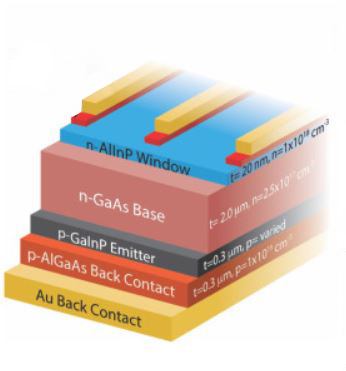NREL has unveiled a new design for III-V rear heterojunction solar cells based on GaAs, in order to make PV devices for terrestrial applications.
Solar cells manufactured from GaAs and gallium indium phosphide (GaInP) have long yielded some of the highest conversion efficiencies of any technology. Bringing down production costs to make them viable for mainstream solar applications remains a challenge, despite recent scientific suggestions for various approaches to using GaAs and other III-V materials in solar devices.
The scientists said the novelty of their approach consisted of using dynamic hydride vapor phase epitaxy (D-HVPE), as an alternative lower-cost solution to metal organic vapor phase epitaxy (MOVPE), to synthesize the solar cell. HVPE, on the other hand, uses low-cost elemental group III precursors with high utilization efficiency and very high growth rates.
They also applied an emitter layer of gallium indium arsenide phosphide (GaInAsP), which makes the cell’s heterojunction together with the GaAs absorber.
“For processing, a reflective Au metal contact was electroplated onto the AlGaAs contact layer, and then samples were inverted onto a Si handle, and the substrate was etched away followed by the etch stop,” they explained.
The academics identified an optimum emitter doping density and energy bandgap to maximize the cell efficiency, and said that the size of this varies with the heteroband offsets, as defined by the material choice.
NREL’s Cell and Module Performance (CMP) Team has certified that the novel cell design achieved a power conversion efficiency of more than 27%. The researchers said this is the highest efficiency ever reported for a single-junction GaAs cell grown using this technique.

They presented the cell in “Modeling and design of III-V heterojunction solar cells for enhanced performance,” which was recently published in Cell Reports Physical Science.
“We also show that heterojunctions yield proportionally larger efficiency improvements in lower-quality materials,” they concluded. “Although the modeling was developed and validated using III-V materials, the results are theoretically applicable to materials systems outside III-Vs.”
This content is protected by copyright and may not be reused. If you want to cooperate with us and would like to reuse some of our content, please contact: editors@pv-magazine.com.









By submitting this form you agree to pv magazine using your data for the purposes of publishing your comment.
Your personal data will only be disclosed or otherwise transmitted to third parties for the purposes of spam filtering or if this is necessary for technical maintenance of the website. Any other transfer to third parties will not take place unless this is justified on the basis of applicable data protection regulations or if pv magazine is legally obliged to do so.
You may revoke this consent at any time with effect for the future, in which case your personal data will be deleted immediately. Otherwise, your data will be deleted if pv magazine has processed your request or the purpose of data storage is fulfilled.
Further information on data privacy can be found in our Data Protection Policy.